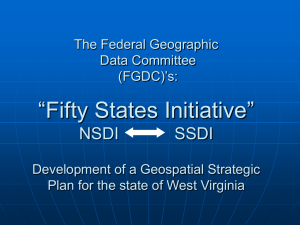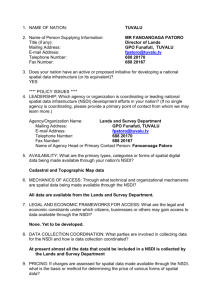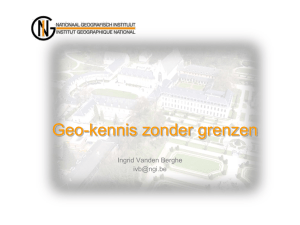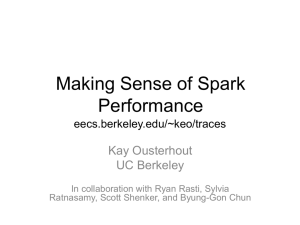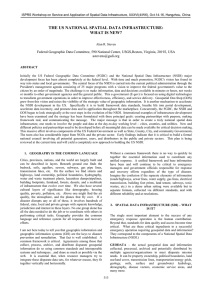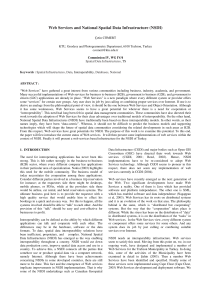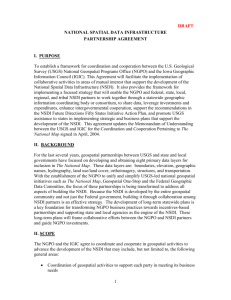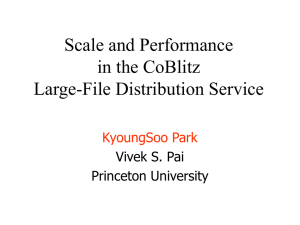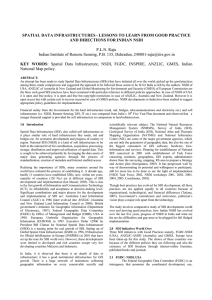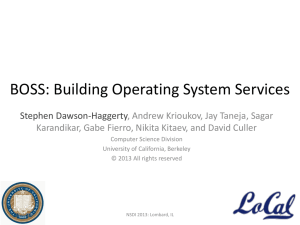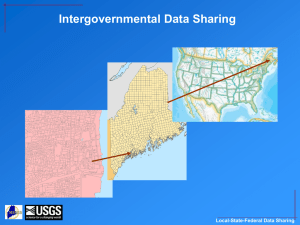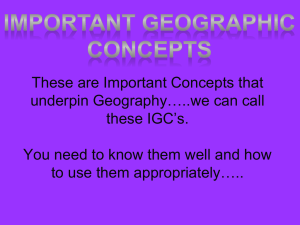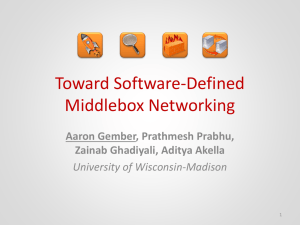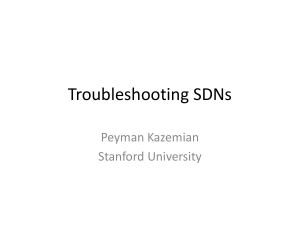NSDI Intro version 2
advertisement
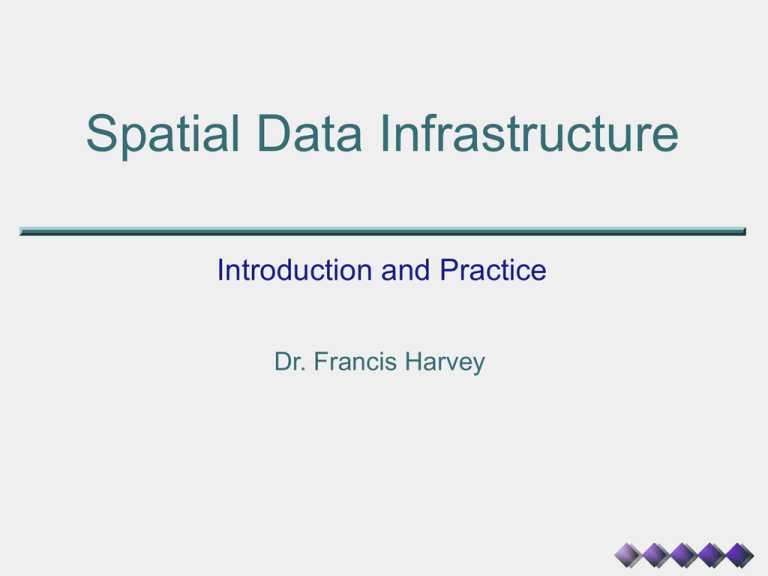
Spatial Data Infrastructure Introduction and Practice Dr. Francis Harvey SDI or NSDI • National Spatial Data Infrastructure (NSDI) in US is where concept originates • It has since evolved (mainly in Europe) • Elements remain the same • Principles have changed • Still very complex NSDI in America The Political Culture ▪ From DC Beltway to “Main Street” ▪ Jeffersonian Democracy ▪ Federalism ▪ Enfranchised, pluralistic, participative populace ▪ Participative Democracy Dimensions of American Government ▪ In mid-1990s non-defense Federal agencies employed about 2.1 million people and spent about $1.6 trillion ▪ State and local governments employed 19.5 million people and spent about $1.3 trillion (1994) ▪ There are about 39,000 general purpose units of local government ▸ 3000 counties ▸ 19,000 cities ▸ 16,000 towns ▸ 14,000 school districts ▸ 31,000 special districts Minneapolis, St. Paul Metropolitan Area General 7 700 km2 around 1 million residents about 900 000 parcels 293 independent local units of government 7 188 59 39 counties Other governm. units school districts water boards From Randy Johnson, MetroGIS NSDI originates in U.S. Federal Government ▪ Executive Order 12906 (1994) calls for sharing ▸ Avoid duplicate efforts ▸ More efficient use of resources ▪ This only involves Federal Agencies ▸ Coordinated through Federal Geographic Data Committee ▪ Framework should provide foundation ▸ No master blueprint NSDI to serve many needs At all levels of government ▪ Transportation, Navigation & Commerce ▪ Public Land & Marine Sanctuary Management ▪ Agriculture & Natural Resource Development ▪ Environmental Protection and Ecosystem Management ▪ Community and Economic Development ▪ Emergency Management ▪ Public Service Delivery ▪ National Defense ▪ Earth System Science & Geographic Information Technologies ▪ Public Information ▪ Property & Voting Rights ▪ Revenues Source: National Academy of Public Administration, 1997 What is the NSDI? ▪ Infrastructure for Institutions ▸ Big vision: – From local citizen to Federal Secretaries ▸ Builds on locally distinct institutions and infrastructures – Mainstreet ▸ Not a template, but a framework to guide development ▸ Not a uniform code, only guidelines and standards NSDI Components ▪ Framework ▪ Framework Cone ▪ Involvement and data sharing ▪ Metadata ▪ Clearinghouses Three Key NSDI Components Vertical and Horizontal Integration Application Users Added Application-Specific Data Transportation Planning Traffic Loads Framework Data Population Soils Land Suitability Analysis Free Data Sharing Development Planning NSDI starts with Framework Data Federal Government Project/Proposal Framework Cone Involvement and Data Sharing Federal, Regional, State, Tribal, Local, Private Companies, Utilities Application Users Added Application-Specific Data Transportation Planning Traffic Loads Framework Data Population Soils Land Suitability Analysis Development Planning NSDI Iceberg Application Users Added Application-Specific Data Transportation Planning Concepts Practices Traffic Loads Framework Data Soils Land Suitability Analysis ? Population Development Planning Recognized Issues ▪ Data Sharing (level 1 interoperability) ▸ How is data exchanged? ▪ Defining geographic objects (semantics) ▸ What is a road? ▪ Sharing costs (financial) ▸ Who pays? ▪ Involving local governments (participation) ▸ More bureaucracy? ▪ Vertical Integration (control, use, and distribution) ▸ Data and Organizations The two sides of data sharing are the two sides of integration Simplistic: Technical and Institutional Issues ▪ Technical issues ▸ Multiple scales ▸ Data exchange ▪ Institutional Issues ▸ Cost-sharing ▸ Maintenance ▸ Metadata Cone of Vertical Integration Vertical Integration Technical Issues can be resolved ▪ Products and levels ▸ Multiple producers, multiple users, multiple products ▸ State, Federal, Local ▪ NSDI operates like a federation ▸ Distributed production ▸ Diffused use ▸ Multiple production and use arrangements Institutional Issues for Integration ▪ Relevance ▸ Scale related ▪ Partnerships to provide resources ▸ Joint funding ▸ Cost sharing ▸ Work sharing Underlying Organizational Issues Difficult to assess ▪ “Pride of Authorship” ▪ Adequacy for use ▪ Duplication of effort ▪ Reprocessing costs ▪ Not easily automated ▪ Political and public pressures ▪ Disparate data ▪ Lack of time ▪ Legal issues Evolution of the NSDI Development of Capabilities and Political Turf ▪ FGDC ▸ Coordinating (federal) actvities ▸ 19 member interagency committee ▪ Geospatial One-Stop ▸ Access way to geospatial information ▪ The National Map ▸ Partnerships to provide integrated geographic data (synthesis) FDGC www.fgdc.gov ▪ In existence since 1990 ▸ Big push came after 1994 Executive Order to develop the NSDI ▪ Develops and promotes standards ▸ Notably for metadata – The CSDGM, Content Standard for Digitial Geographic Metadata ▪ Promotes inter-governmental activities ▪ Responsible for clearinghouses GeoSpatial OneStop Geodata.gov ▪ What is it? ▸ Federal agencies (24) continuing NSDI activities ▸ Part of Bush’s e-government agenda – Strong private sector involvement ▸ Focus: Spatially enable the delivery of government services ▪ Technology is a portal ▸ A gateway to gateways and data National Map http://nationalmap.usgs.gov/ ▪ What is it? ▸ “a seamless, continuously maintained set of public domain geographic base information that will serve as a foundation for integrating, sharing, and using other data easily and consistently” ▪ Linked to the National Atlas ▸ National Map has data ▸ National Atlas has maps Is this all just a mess? ▪ No, simply what happens when politics and bureaucracy intersect with technologies Materials A Brief Selection ▪ The best starting web site is www.fgdc.gov ▸ From this site you will be able to find links to all sorts of information on the NSDI ▸ Global SDI information is at www.gsdi.org ▪ For technical issues start out with www.opengis.org ▪ For operational examples go to nsdi.usgs.gov or search for ‘NSDI’ NSDI Practices In the beginning... Aligning scientific communities with policy communities ▪ Re-inventing government ▸ Gore-lead initiative: National Performance Review – Management for results – Inter-government activities – Performance-based organizations ▸ Activities (relevant) – G-Gov – NSDI – Reinventing government ▪ Continued under Bush e-government Government Needs for the 21st Century ▪ Interoperable systems that are trusted and secure ▪ Methods and measures of citizen participation in democratic processes ▪ Models of electronic public service transactions and delivery systems ▪ New models for public-private partnerships and other networked organizational forms ▪ Intuitive decision support tools for public officials ▪ Archiving and electronic records management ▪ Better methods of IT management ▪ Matching research resources to government needs NSDI ... a verb? ▪ Nancy Tosta’s commentary ▸ A key figure in 1990s NSDI work ▸ Politics and bureaucracy ▪ Troubles ▸ “diverse interpretations” ▸ “broad management options” ▪ Failures ▸ No nationally consistent data sets ▸ Slow development of standards Research ▪ Interactions among levels of government and public and private sectors ▪ Policy guidelines, organizational forms, and technology tools constantly interact Institutional Issues for Integration ▪ Relevance ▸ Scale related ▪ Partnerships to provide resources ▸ Joint funding ▸ Cost sharing ▸ Work sharing Critical Organizational Issues Difficult to assess ▪ “Pride of Authorship” ▪ Adequacy for use ▪ Duplication of effort ▪ Reprocessing costs ▪ Not easily automated ▪ Political and public pressures ▪ Disparate data ▪ Lack of time ▪ Legal issues Decentralizing Infrastructure Neo-liberalizationof governance ▪ Does Decentralization = Devolution? ▪ Different strategies ▸ Shift dissatisfaction ▸ Shift economic and political powers to increase local revenue ▸ Shift of expenditures w/o revenues Economic Explanation ▪ Shift expenditures decisions to the level of government that best incorporates a community of common interests ▪ Central government concessions to maintain political stability ▸ Very fluid structure of governance – Network No easy Job Changing the relationship between central and local governments ▪ Problems of public service delivery ▸ Local service provision cannot be changed in isolation ▸ Different degrees of political, economic, and decision making powers Three Elements of Success ▪ Clear distinction of functional responsibilities ▪ Financial rules governing local governments reward good performance ▪ System of accountability that balances central regulation and local political participation Assumptions ▪ Difficulties of defining the beneficiaries of a particular service (benefit-jurisdiction model) ▪ Many services have local and wider benefits ▪ Administrative costs associated with service provision are not factored in ▪ Data sharing occurs to share data Successful Decentralization Finances and Politics ▪ Democratic local decision process with transparent costs and benefits and all stakeholders have an equal opportunity to influence the decision ▪ Costs of local decisions are borne by those who make decisions ▪ Benefits stay in the jurisdiction Policy Guidelines Does NSDI fulfill these? ▪ Who benefits, pays? ▪ Transparent lines of accountability ▪ Provide enforcement mechanism Technology and Organizations are inseperable NSDI Awareness What is the NSDI???? ▪ For “small” local governments the NSDI has no relevance ▪ They don’t know what it is ▪ They can’t imagine what it is Do you know what the National Spatial Data Infrastructure is? (Y/N) Unsure (6.90%) Yes (43.10%) No (50.00%) Results from 2001 Kentucky Survey Informal data sharing dominates Results for local governments from 1996 Framework Survey Sh ar e D ata H ave Po li cy 0 20 40 60 80 100 in per cen t K entu cky (n =15) K ansas (n =20) N o rth C aro li na (n =70) Washi n gto n (n =31) Data Distribution Are there conditions [e.g., "no use", "no distribution"] stipulated upon the sharing, use, or redistribution of data? ▪ Regional differences ▸ Established regional agencies ▸ With colleges and tribal authorities ▪ Specific Issues ▸ “liability disclaimer required” ▸ “data only used for requested purpose & not shared w/ others w/o permission” ▸ "the only data we want to "protect" is the cadastral layer” Yes No N/A etc Results from Best Practices Research Limits to the Effectiveness of Standards Do you rely on any standards in your geographic information activities? ▪ What does “yes” mean? ▸ “when I'm aware of standards that I can meet” ▸ “standards??? Order of priorities-real time needs first” ▸ “ArcView shapefiles, UTM or County coordinates for basemap purposes” ▸ “occasionally we will use the National Spatial Accuracy Standards (when create metadata)” Yes No NA n/a etc Terminological Problem: standard can mean little more than using what is available when there is only one choice Results from Best Practices Research Resources Questions?

